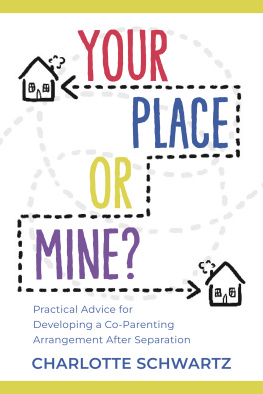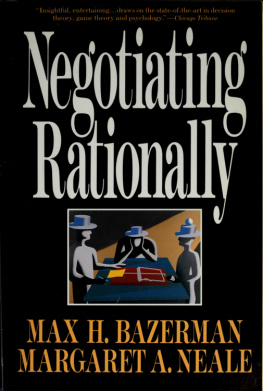Negotiating at Home
Negotiating at Home
Essential Steps for Reaching Agreement with Your Kids
Terri R. Kurtzberg and Mary C. Kern

Copyright 2020 by Terri R. Kurtzberg and Mary C. Kern
All rights reserved. No part of this publication may be reproduced, stored in a retrieval system, or transmitted, in any form or by any means, electronic, mechanical, photocopying, recording, or otherwise, except for the inclusion of brief quotations in a review, without prior permission in writing from the publisher.
Library of Congress Cataloging-in-Publication Data
Names: Kurtzberg, Terri R., author. | Kern, Mary C., author.
Title: Negotiating at home : essential steps for reaching agreement with your kids / Terri R. Kurtzberg and Mary C. Kern.
Description: Santa Barbara : Praeger, 2020. | Includes bibliographical references and index.
Identifiers: LCCN 2019058145 (print) | LCCN 2019058146 (ebook) | ISBN 9781440868108 (hardcover) | ISBN 9781440868115 (ebook)
Subjects: LCSH: ParentingPsychological aspects. | Parent and childPsychological aspects. | Negotiation. | Decision making.
Classification: LCC HQ755.8 .K476 2020 (print) | LCC HQ755.8 (ebook) | DDC 306.874dc23
LC record available at https://lccn.loc.gov/2019058145
LC ebook record available at https://lccn.loc.gov/2019058146
ISBN: 978-1-4408-6810-8 (print)
978-1-4408-6811-5 (ebook)
24 23 22 21 20 1 2 3 4 5
This book is also available as an eBook.
Praeger
An Imprint of ABC-CLIO, LLC
ABC-CLIO, LLC
147 Castilian Drive
Santa Barbara, California 93117
www.abc-clio.com
This book is printed on acid-free paper 
Manufactured in the United States of America
This book is dedicated to Jillian and Lucas and Joe and Lexi, who always keep us on our toes, and without whom we would know nothing at all about negotiating with children.
TRK & MCK
Acknowledgements: We are grateful to Rochelle Autin, Kim Colasanti, Lauren Ross Feldman, Mari Pagone Franklin, Jim Freeman, Tom Freeman, Kate Groff, Stacy Paleski, Krista Szarck, Sari Uricheck, and the hundreds of parents whom we interviewed for this book and who freely shared stories from their homes.
Contents
Negotiating with kids can sometimes feel like stepping into quicksand. It can happen immediately and with little warning, and can be instantly overwhelming. Its easy to lose your bearings and find yourself acting in ways you didnt expect and dont necessarily like, especially because everything keeps changing. While governments can decide on a we dont negotiate with terrorists stance, parents who try the home version of we dont negotiate with toddlers or teenagers will find that its not very practical.
We spend an awful lot of time negotiating with our kidsover everyday requests, rules and policies, and big decisions. This book offers a chance to look more closely at what you already do well (and why) and what you can do better. It builds on both the science of negotiations and on the skills you already use in other areas of your life, so that you can navigate these interactions in a way youre proud of. You want to move out of the quicksand and back to solid ground.
Though it would be reassuring to have a specific list of things to do and say for each situation, thats not realistic. No book, article, lecture, or specialist can provide an exact do this! when you face tough moments with any guarantee of it working. Parents and kids interact in truly unique ways, and nobody knows your kids better than you do. Youve become the parent you are because of the children you are raising. What works in your family wont necessarily work in ours and vice versa.
However, running right alongside the unique aspects of your life at home are the commonalities that you share with so many other parents. From combing through the research on parenting and negotiations, and from speaking to hundreds of parents while writing this book, we recognize that there are patterns to negotiations with kids that we can all learn from. As parents, professors, and researchers ourselves, its our job to cull these commonalities and distill the lessons in them. There are tools to be borrowedtools about how to plan, how to recognize specific tactics, how to communicate and work in partnerships with other family members, and how to handle conflict. Whether you choose the proverbial hammer, wrench, level, or bandage in any particular moment, though, is going to be up to you.
Remember the first time you held your newborn, that delicate bundle of adorable tiny fingers and baby yawns and loving gazes? Do you also remember the red-faced screams, sleepless nights, and the never-ending messes? You may have felt a mixture of love and panic. You may have looked for the manual that clearly should have come with them, telling you how to raise this person. You may have even felt like an imposter at the beginning, as so many people do. You parent every day, and you gain skills in handling one set of things just as an entirely new set of things comes barreling toward you. This book aims to both explore the things you already know and to introduce new ideas.
The new ideas come from the science on leadership, psychology, education, negotiations, communication, and parenting. But even within these, some ideas may feel like commonsense and things that you already know. So, why spend time reading about these ideas? For one thing, even if we have a sense of the right path forward, understanding more about why and how certain tactics and techniques work can allow us to make better choices about which tools to use when. For another, when it comes to important ideas and lessons in life, it turns out we can all always use reminders. We do forget a lot of what we learn. And finally, without repeated exposure, the ideas and lessons that we might be able to discuss clearly when were out of the situation, while feeling calm and focused on the direction wed like to take, may be nowhere near the surface when we need them. (One parent described her shock when she actually tried the long-heard advice to stop and count to 10 when losing her temper, and found it helpful. It had taken many times of hearing the idea to finally remember to do it in the heat of the moment.) Despite our best intentions, our behaviors often slide away from the way we mean for things to go. This is especially true of the interactions that happen after you hit the Thats it! Ive had it! wall. It can take a lot of effort to get past those moments.
Even experts benefit from reminders and review of basic concepts. By way of example, a professional hostage negotiator once enrolled in a five-day negotiations training session, which was more typically attended by novice negotiators. When asked why he was there, he shared that he attended a similar training session every year. He said that it helped him do his job better to have regular reminders of what makes for an effective negotiation. It needs to be a habit, he explained. Otherwise, whatever youve learned will probably fly out the window when it really counts. Something that has been repeated often enough that it becomes the default for you to execute only comes with enough exposure.
This book is divided into three sections, which together provide the essential steps for reaching an agreement with your kids. Step One is called Cracking the Negotiations Code, in which the lessons learned from the realm of professional negotiations are applied to the particular interactions between parents and children. In the first chapter, we provide an introduction to the topic and a sense of scope about negotiations with kids, as over the course of the thirteen years between the ages of five and eighteen, parents spend approximately 468 full eight-hour days negotiating with them. Thats a lot of time! We also explain why its so hard to transfer the skills you may use repeatedly and successfully in other settings to life at home. identifies the main strategic approaches available when negotiating with your childrenusing your power, creating and relying on rules and precedent, or seeking insight into the bigger issues important to you both.











